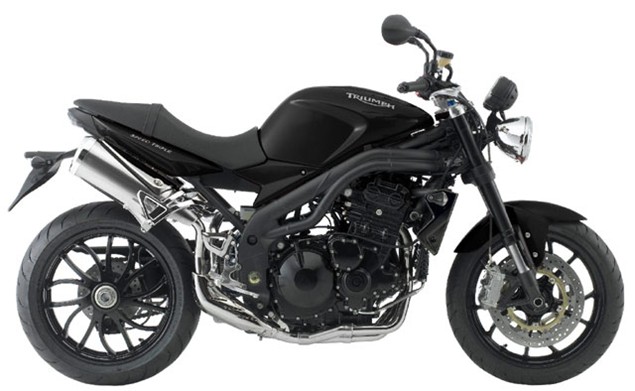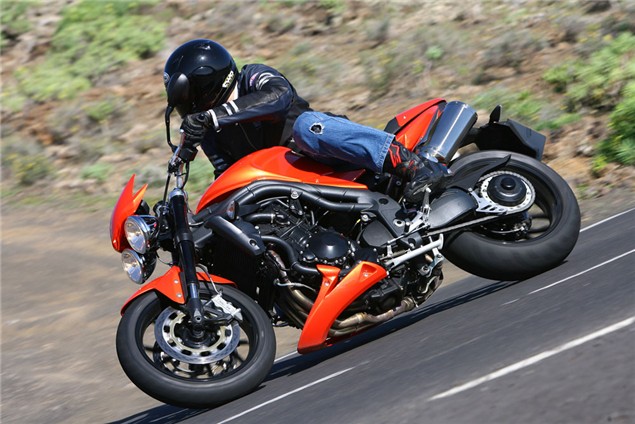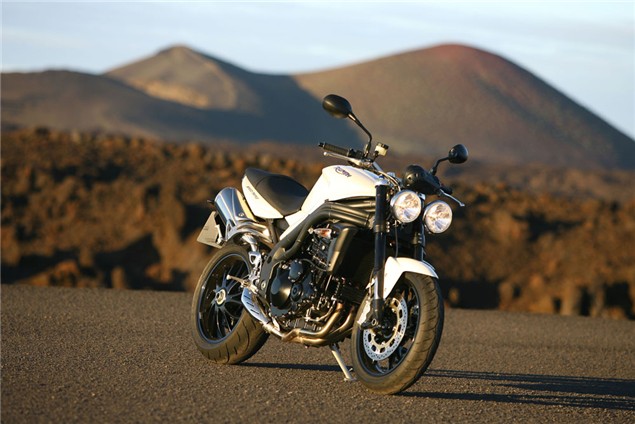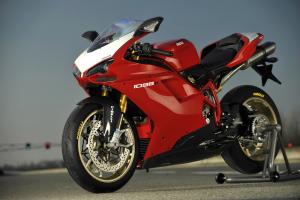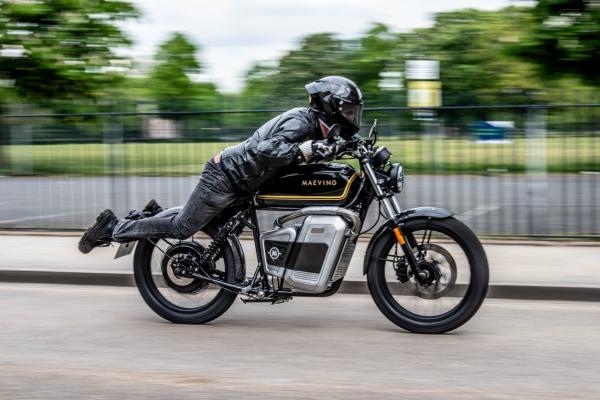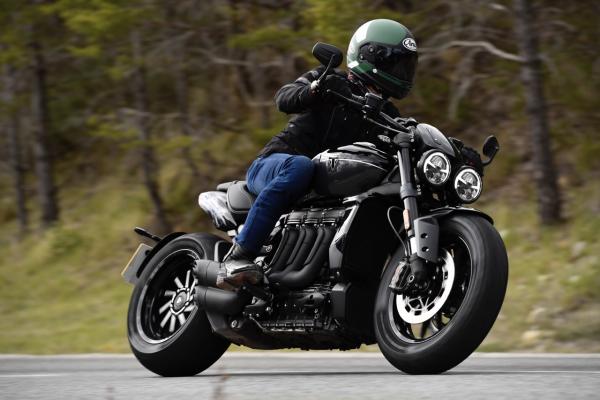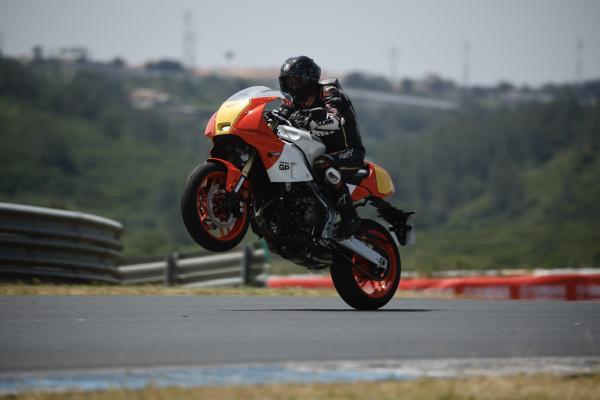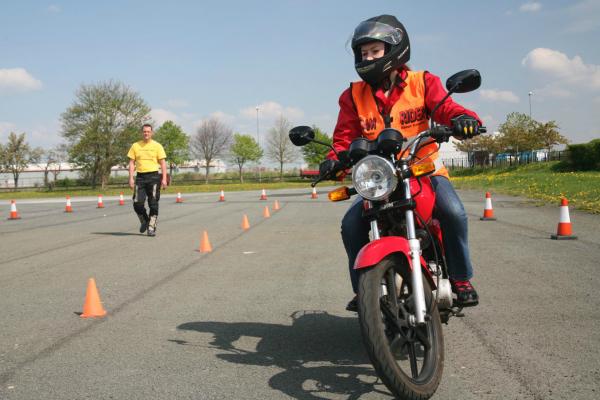It’s Triumph best selling bike, a style icon, movie star and it’s still only 14 years old. Life is anything but dull with the Speed Triple as Jon Urry finds out on the roads of Lanzarote. I was a little surprised when Triumph invited us out to Lanzarote to ride its 2008 Speed Triple. As far as I could tell the bike had only gained a set of flash new wheels and a slightly different rear end in its first update since it went all stubby in 2005. Quite what was the point in Triumph dragging us to an Island just off Africa populated by so many geriatrics it looked like a set from ‘Land of the Dead’ was a mystery. So, during the model presentation I was paying more than my usual cursory amount of attention. After just a few minutes it became apparent how much the Speed Triple means to Triumph. This bike encapsulates everything that the new Hinckley Triumphs are about. It’s bold, different and instantly recognisable. Just some of the reasons why the Triple is Triumph’s best selling bike ever, shifting 46,239 units in its 14-year life. Not bad for a bike that started out as a designer’s project hack. Much like Aprilia’s Tuono the Speed Triple was born from someone realising that naked bikes are a really good laugh to ride. Except this particular Brit realised it 10 years earlier than his Italian counterpart. He whipped the fairing off a Trident 900 and hey presto, the Speed Triple was born to instant success. In its first year Triumph sold 1,100 bikes, which represented 16% of its total sales. A few years later (1997) the Triple gained its now iconic twin headlight setup and flat bars before remaining visually fairly similar (barring some vomit-inducing paint schemes) until 2005 when, along with the new 1050 engine, came twin stubby cans and an overall sharper look. But this model was also a very significant step in the Speed Triple’s life, this was the first time the bike was designed in its own right, rather than simply being a naked version of an already existing faired bike. The Speed Triple had come of age, and was a more important model to Triumph than a big capacity sportsbike brother. So, three years down the line what’s new with the 2008 bike? To be fair not a great deal. Important bits first, the chassis is unchanged and the forks only get a new black look, the 1050 motor is identical to before and still makes 131bhp and 77ft.lb of torque, and the swingarm is untouched. The biggest change, well visually anyway, is the new wheels. With a unique design these are marginally lighter than before but look a million times better with their bendy style, especially the 14-spoke rear. But the most significant changes are much more subtle, and are the result of rider surveys. The quite frankly ridiculous and virtually suicidal pillion seat has been increased in length by 20mm (to take into account the rapid expansion of the modern female posterior) and, along with the rider’s seat, is flatter. This, with new 50mm lower pillion pegs, should reduce the number of Speed Triple pillions scattered around the countryside in areas of high acceleration. Although a few may soon be found distributed in braking areas because Triumph has uprated the already fairly respectable front set-up on the Speed Triple. A new Nissin radial master cylinder (from the Daytona 675) combined with a new Brembo four-piston radial calliper give, according to Triumph, 14% more braking performance with 12% more initial bite. Quite how they came by this figure is a bit of a mystery, personally I reckon they lined up 100 ants in the braking zone and saw how many more got flattened with the old bike compared to the new. Although I could be wrong. Ant murder aside Triumph has basically spent the last few years refining the Speed Triple in small but fairly significant ways, which is what it feels like to ride. There are no huge shocks to be had on the 2008 model if you are used to the previous one. It feels, behaves and when you are on it looks the same as the older version, but much the same way your bike feels that bit sharper with new tyres fitted the 2008 Speed Triple feels refreshed. Through the corners the bike feels slightly sharper to respond to inputs. The new design front wheel is 5% lighter than before, but significantly Triumph has changed the tyre supplier from Michelin to Dunlop and Metzeler. I’m not going to get into a direct tyre comparison here, because the bike itself has changed as well as the rubber, but the Triumph test riders claimed that the choice was driven by improved cornering ability and stability and I wouldn’t argue with that. The Speed Triple retains the same balance as before, helped by its excellent (and unchanged) road suspension, but definitely feels a bit nippier. Having spent quite a lot of time riding all of the current large naked bikes I’ve developed quite a soft spot for the Speed Triple. It’s not the best handling bike in its class, that award goes to the 990 Super Duke, but it’s got the best road manners of the bunch. Triumph has a habit of getting road suspension just right and in refusing to play around with the Speed Triple’s the 2008 bike retains this beautiful balance, and the engine is a peach. Okay, the Speed Triple doesn’t punch out the big horsepower figures like the Z1000 or FZ1, but the triple engine is so much nicer to use than either of these inline fours. The power starts as low as 2,000rpm and builds seamlessly until the red line cuts in. Unlike the FZ1 there is no missing bottom end and ridiculous top end power, just constant drive. So what if it ‘only’ makes 131bhp (or 117bhp in reality at the rear wheel) how many times do you really want to go over 100mph on a street bike? Not many I’d wager. Street bikes are ridden at lower speeds and as such demand low and mid range punch, and none have it lower than the Triumph. As you would expect on a bike like this there is more than the slight temptation to wheelie it, a point when the Speed Triple shows just how strong it is off the bottom end. Having spend a fair amount of the day wheelying the bike around when the time came to do it in front of the camera man I got a terrible burst of stage fright and succeeded in only accelerating fast. After about six fruitless attempts I was starting to think I had lost the plot, but then I realised I was trying to do it too high up the rev range. In second gear all you need on the rev counter is 2,000rpm, a flick of the clutch and you’re away, such is the strength of the bottom end. Try it much higher up the range and it doesn’t respond half as well. All very embarrassing, especially as the Triumph test rider (British Supersport rider Paul Young) was looking on with some mirth. Never mind, back with two wheels on the ground and the new front braking set up was proving very impressive. Over the years Triumph has come in for a bit of criticism over its front brakes. Speed Triples and the Sprint ST do sometimes suffer from fading brakes and a lot of lever movement but this new set-up looks likely to solve these issues. I’ve not heard of any problems with the Dayton 675’s brakes, so the master cylinder should be up to the job, and Brembo seem to know what they are up to when it comes to stoppers. The new system provides a much stronger initial bite than before, but without sacrificing too much feel. Despite steel lines as standard the brakes don’t have too much of that solid feel that you can get with steel lines and I found them excellent. Remembering this is a road bike first and foremost I don’t think they are over-kill, but I would advise owner to treat them with respect, especially in the wet. Something the 700-odd UK bound Speed Triples are likely to see a lot of, especially if owners live in the Tewkesbury area. Although I was disappointed that Triumph didn’t choose to use this update to give the Speed Triple a gear indicator, better steering lock and sidestand that you can actually get out the changes it has made are small but significant. The new wheels are purely a quick fix to give the bike a fresh image, but the improved pillion provisions are a very worthy revision. Some may find the braking performance a bit too aggressive, but I found it was sharp but didn’t have the lack of feel that you get with some systems. As for the other cosmetic changes, all I can say is good riddance to the horrible tacky chrome-plated bars. Street bikes need a big set of chunky bars, not something that would look at home on a Raleigh bicycle. I like the new blacked out fork legs and while some say the twin headlight is old fashioned I’m on Triumph’s side, it’s an instantly recognisable Speed Triple (or Street Triple) look. Just look at the movie poster for Mission Impossible for evidence of this, unmistakably a Triumph. So, with 46,239 bikes sold and 14-years under its belt the future looks good for Triumph’s old war-horse. Although it’s unlikely to ever tread the red carpet at the Oscars it’s still won an army of fans, and deservedly so. | |||||||||||||||
I was a little surprised when Triumph invited us out to Lanzarote to ride its 2008 Speed Triple. As far as I could tell the bike had only gained a set of flash new wheels and a slightly different rear end in its first update since it went all stubby in 2005. Quite what was the point in Triumph dragging us to an Island just off Africa populated by so many geriatrics it looked like a set from ‘Land of the Dead’ was a mystery. So, during the model presentation I was paying more than my usual cursory amount of attention.
After just a few minutes it became apparent how much the Speed Triple means to Triumph. This bike encapsulates everything that the new Hinckley Triumphs are about. It’s bold, different and instantly recognisable. Just some of the reasons why the Triple is Triumph’s best selling bike ever, shifting 46,239 units in its 14-year life. Not bad for a bike that started out as a designer’s project hack.
Much like Aprilia’s Tuono the Speed Triple was born from someone realising that naked bikes are a really good laugh to ride. Except this particular Brit realised it 10 years earlier than his Italian counterpart. He whipped the fairing off a Trident 900 and hey presto, the Speed Triple was born to instant success. In its first year Triumph sold 1,100 bikes, which represented 16% of its total sales. A few years later (1997) the Triple gained its now iconic twin headlight setup and flat bars before remaining visually fairly similar (barring some vomit-inducing paint schemes) until 2005 when, along with the new 1050 engine, came twin stubby cans and an overall sharper look. But this model was also a very significant step in the Speed Triple’s life, this was the first time the bike was designed in its own right, rather than simply being a naked version of an already existing faired bike. The Speed Triple had come of age, and was a more important model to Triumph than a big capacity sportsbike brother.
So, three years down the line what’s new with the 2008 bike? To be fair not a great deal. Important bits first, the chassis is unchanged and the forks only get a new black look, the 1050 motor is identical to before and still makes 131bhp and 77ft.lb of torque, and the swingarm is untouched. The biggest change, well visually anyway, is the new wheels. With a unique design these are marginally lighter than before but look a million times better with their bendy style, especially the 14-spoke rear. But the most significant changes are much more subtle, and are the result of rider surveys.
The quite frankly ridiculous and virtually suicidal pillion seat has been increased in length by 20mm (to take into account the rapid expansion of the modern female posterior) and, along with the rider’s seat, is flatter. This, with new 50mm lower pillion pegs, should reduce the number of Speed Triple pillions scattered around the countryside in areas of high acceleration. Although a few may soon be found distributed in braking areas because Triumph has uprated the already fairly respectable front set-up on the Speed Triple.
��
A new Nissin radial master cylinder (from the Daytona 675) combined with a new Brembo four-piston radial calliper give, according to Triumph, 14% more braking performance with 12% more initial bite. Quite how they came by this figure is a bit of a mystery, personally I reckon they lined up 100 ants in the braking zone and saw how many more got flattened with the old bike compared to the new. Although I could be wrong.
Ant murder aside Triumph has basically spent the last few years refining the Speed Triple in small but fairly significant ways, which is what it feels like to ride. There are no huge shocks to be had on the 2008 model if you are used to the previous one. It feels, behaves and when you are on it looks the same as the older version, but much the same way your bike feels that bit sharper with new tyres fitted the 2008 Speed Triple feels refreshed.
Through the corners the bike feels slightly sharper to respond to inputs. The new design front wheel is 5% lighter than before, but significantly Triumph has changed the tyre supplier from Michelin to Dunlop and Metzeler. I’m not going to get into a direct tyre comparison here, because the bike itself has changed as well as the rubber, but the Triumph test riders claimed that the choice was driven by improved cornering ability and stability and I wouldn’t argue with that. The Speed Triple retains the same balance as before, helped by its excellent (and unchanged) road suspension, but definitely feels a bit nippier.
Having spent quite a lot of time riding all of the current large naked bikes I’ve developed quite a soft spot for the Speed Triple. It’s not the best handling bike in its class, that award goes to the 990 Super Duke, but it’s got the best road manners of the bunch. Triumph has a habit of getting road suspension just right and in refusing to play around with the Speed Triple’s the 2008 bike retains this beautiful balance, and the engine is a peach.
Okay, the Speed Triple doesn’t punch out the big horsepower figures like the Z1000 or FZ1, but the triple engine is so much nicer to use than either of these inline fours. The power starts as low as 2,000rpm and builds seamlessly until the red line cuts in. Unlike the FZ1 there is no missing bottom end and ridiculous top end power, just constant drive. So what if it ‘only’ makes 131bhp (or 117bhp in reality at the rear wheel) how many times do you really want to go over 100mph on a street bike? Not many I’d wager. Street bikes are ridden at lower speeds and as such demand low and mid range punch, and none have it lower than the Triumph.
As you would expect on a bike like this there is more than the slight temptation to wheelie it, a point when the Speed Triple shows just how strong it is off the bottom end. Having spend a fair amount of the day wheelying the bike around when the time came to do it in front of the camera man I got a terrible burst of stage fright and succeeded in only accelerating fast. After about six fruitless attempts I was starting to think I had lost the plot, but then I realised I was trying to do it too high up the rev range. In second gear all you need on the rev counter is 2,000rpm, a flick of the clutch and you’re away, such is the strength of the bottom end. Try it much higher up the range and it doesn’t respond half as well. All very embarrassing, especially as the Triumph test rider (British Supersport rider Paul Young) was looking on with some mirth.
Never mind, back with two wheels on the ground and the new front braking set up was proving very impressive. Over the years Triumph has come in for a bit of criticism over its front brakes. Speed Triples and the Sprint ST do sometimes suffer from fading brakes and a lot of lever movement but this new set-up looks likely to solve these issues. I’ve not heard of any problems with the Dayton 675’s brakes, so the master cylinder should be up to the job, and Brembo seem to know what they are up to when it comes to stoppers. The new system provides a much stronger initial bite than before, but without sacrificing too much feel. Despite steel lines as standard the brakes don’t have too much of that solid feel that you can get with steel lines and I found them excellent. Remembering this is a road bike first and foremost I don’t think they are over-kill, but I would advise owner to treat them with respect, especially in the wet. Something the 700-odd UK bound Speed Triples are likely to see a lot of, especially if owners live in the Tewkesbury area.
Although I was disappointed that Triumph didn’t choose to use this update to give the Speed Triple a gear indicator, better steering lock and sidestand that you can actually get out the changes it has made are small but significant. The new wheels are purely a quick fix to give the bike a fresh image, but the improved pillion provisions are a very worthy revision. Some may find the braking performance a bit too aggressive, but I found it was sharp but didn’t have the lack of feel that you get with some systems. As for the other cosmetic changes, all I can say is good riddance to the horrible tacky chrome-plated bars. Street bikes need a big set of chunky bars, not something that would look at home on a Raleigh bicycle. I like the new blacked out fork legs and while some say the twin headlight is old fashioned I’m on Triumph’s side, it’s an instantly recognisable Speed Triple (or Street Triple) look. Just look at the movie poster for Mission Impossible for evidence of this, unmistakably a Triumph.
So, with 46,239 bikes sold and 14-years under its belt the future looks good for Triumph’s old war-horse. Although it’s unlikely to ever tread the red carpet at the Oscars it’s still won an army of fans, and deservedly so.
INTERVIEW TREVOR BARTON TRIUMPH PRODUCT CO-ORDINATOR
How important is the Speed Triple to Triumph?
The Speed Triple is our most important model, it’s our biggest selling. Over the years it has sold nearly 50,000 units. It has become a style icon, not just in Europe but also the States. We sell about 800 in America, which is really good for this sector. Right the way around the globe it has been successful, especially in 2005 when we updated it to the 1050 engine and new look. But it’s not just commercially important. When it was launched in 1995 the awareness of Triumph was nothing, but the films have made a big difference. The appearance of the Speed Triple in Mission Impossible II was huge. The sales figures jumped up. The film came out in summer 2000 and the sales went up 600 worldwide without the bike being touched at all. Usually you get a peak when the bike is updated then it drops off, but the year Mission Impossible was out showed a huge blip.
Is it a bit of a cult bike then with owners sticking to this model?
Yes, we had a lot of owners from previous models upgrading to the 2005 bike when we updated it but it also attracted a lot of new customers. A large number of the buyers of the 2005 model were new to the brand, new to Triumph, attracted by its look.
How important was customer feedback in the development of the 2008 Speed Triple?
Very. We wanted to make the 2005 bike very stubby so we knew that pillion comfort wasn’t very high up the priority list. But we sat down in 2006 and looked at our feedback and worked out what was important to them. Rider and pillion comfort was mentioned as was the braking performance.
What is in the future for Triumph models?
The street bike sector is one of the only to have a significant growth from 2006 to 2007, so it is very important to us with the Speed and Street Triples. But our philosophy is to have a broad range of bikes over a large number of areas to attract different types of riders. It’s good for us because it’s safe. If, for example, the cruiser market in America isn’t strong we have the modern classic range. We will be broadening this range over the next few years. There are significant new models, not just updates, coming.
Triumph Speed Triple Specs
SPECS:
Price: £7,999
Engine: 1050cc, liquid-cooled, DOHC, 12 valve, three cylinder, four-stroke
Power: 131bhp @ 9,250rpm
torque: 77bhp @ 7,500rpm
Front suspension: 45mm usd fully adj
Rear suspension: Monoshock fully adj
Front brake: 320mm discs,
four-piston Brembo radial calipers
Rear brake: 220mm disc,
single-piston caliper
Dry weight: 189kg (claimed)
Seat height: 815mm
Fuel capacity: 18l
Top speed: 145mph (est)
Colours: White, Black, Orange

